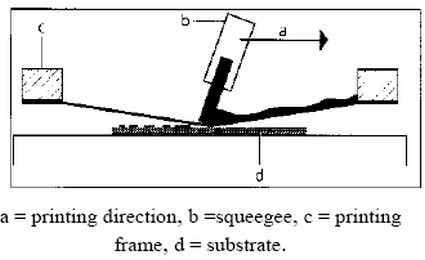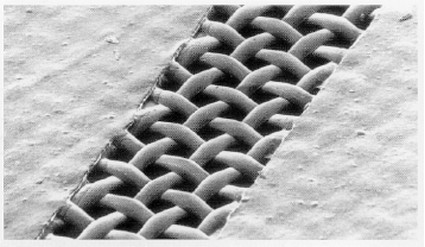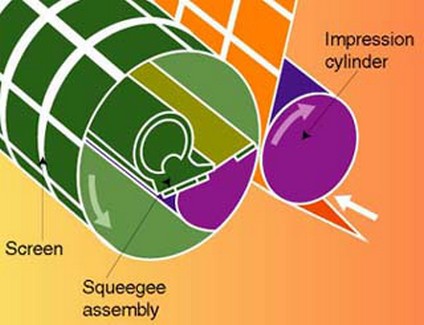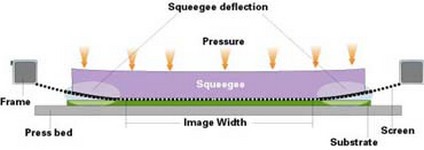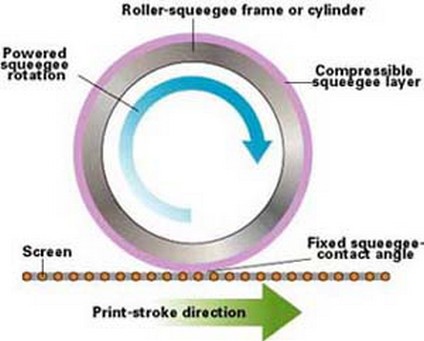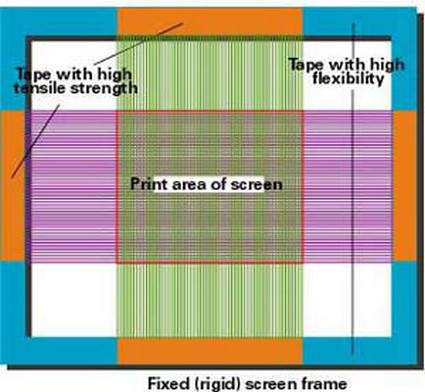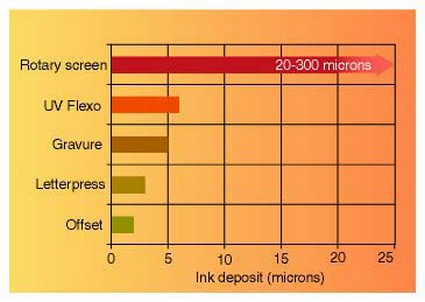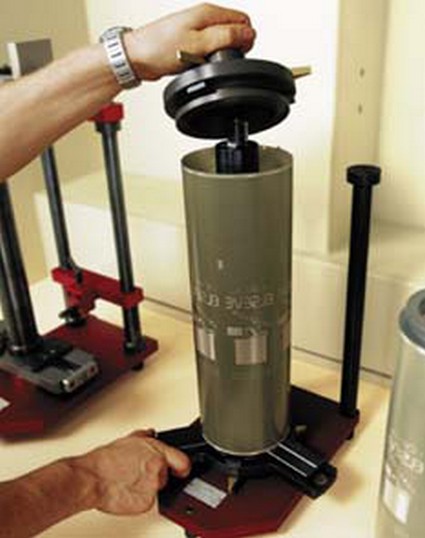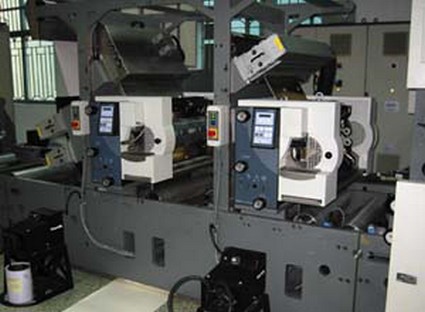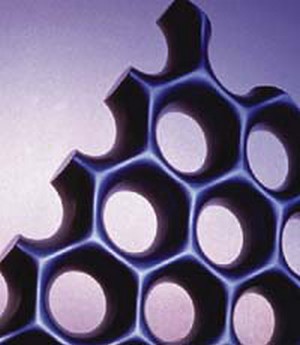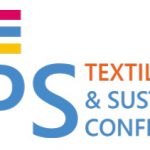Pavan S. Chinta and Prof. S. K. Laga
D.K.T.E.’S Textile and Engineering Institute, Ichalkaranji. – 416115
E-mail Id: [email protected], [email protected]
Introduction
Textile printing is an extensive industry and having a history of about 2000 years. But intensive developments activity both from technological advancement and machinery developments in printing took place in last decade only to meet present days highly fashion oriented demands. Over the years various developments from the point of technology with respect to styles of printing, methods of printing and print paste were going on.Today, 5% of all fabrics produced as white and 70-75% are dyed. 5% is woven from dyed yarns and rest 20% is printed. In industrialized countries, 49% of all printed goods are used for apparel, 37% for home textiles, and 9% to make other articles like umbrellas, linings and camping materials, 4% as a carpet and 1% for technical textiles.
Screen-printing is arguably the most versatile of all printing processes. It can be used to print on a wide variety of substrates including paper, paperboard, plastics, glass, metals, fabrics and many other materials including paper, plastic, glass, metal, nylon and cotton. Some common products from the screen-printing industry include posters, labels, decals, signage and all types of textiles and electronic circuit boards. The advantage of screen-printing over other print processes is that the press can print on substrates of any shape, thickness and size. A significant characteristic of screen-printing is that a greater thickness of the ink can be applied to the substrate than is possible with other printing techniques.
This allows for some very interesting effects that are not possible using other printing methods. Because of the simplicity of the application process, a wider range of inks and dyes are available for use in screen-printing than for use in any other printing process.
Utilization of screen printing presses has begun to increase because production rates have improved. This has been a result of the development of the automated and rotary screen printing press, improved dryers, and U.V. curable ink. The major chemicals used include screen, emulsions, inks, and solvents, surfactants, caustics and oxidizers used in screen reclamation. The inks used vary dramatically in their formulations [1].
Historical Development
The techniques of stencil printing initially used simple patterns on walls and for lettering were developed into an intricate craft for fabric printing. In Japan, in the 17thcentury idea of tying together parts of stencil with human hair initiated the developments. Then in 1850 in Lyon, the first use of silk gauze as a supporting stencil base was employed and the techniques soon becomes known as screen printing.
The use of hand screen-printings grew up in the period of 1930 to 1954 and was ideal for growing quantities of manmade fabrics. With the successful mechanization of flat screen printing and ultimately the use of rotary screen machine copper roller printing becomes the obsolete. In the 1990, the worldwide production from copper roller printing was estimated to be only 16%of the total and 59% from the rotary screen printing in the 1992 the share of share of rotary screen printing has grown up to 82.8%the machine which was introduced in the 1785 and roller printing which rules industry more than 150 years disappeared. The relative contribution of printing methods to the total world printed textile products (in %) is given in Table No. 1.
Very fast developments have taken place in the printing technology during the last decades with respect to machinery used for printing and production of prints and after treatments of the printed textiles. In this paper development regarding the screen-printing, in that flatbed and rotary method is discussed.
Screen Printing
Screen-printing consists of three elements: the screen which is the image carrier; the squeegee; and ink. The screen-printing process uses a porous mesh stretched tightly over a frame made of wood or metal. Proper tension is essential to accurate color registration. The mesh is made of porous fabric or stainless steel mesh.
A stencil is produced on the screen either manually or photo chemically. The stencil defines the image to be printed in other printing technologies this would be referred to as the image plate.
Screen printing ink is applied to the substrate by placing the screen over the material. Ink with a paint-like consistency is placed onto the top of the screen. Ink is then forced through the fine mesh openings using a squeegee that is drawn across the screen, applying pressure thereby forcing the ink through the open areas of the screen. Ink will pass through only in areas where no stencil is applied, thus forming an image on the printing substrate. The diameter of the threads and the thread count of the mesh will determine how much ink is deposited onto the substrates. They are depicted in Figure No. 1.
Many factors such as composition, size and form, angle, pressure and speed of the blade (squeegee) determine the quality of the impression made by the squeegee. At one time most blades were made from rubber, which, however, is prone to wear and edge nicks and has a tendency to warp and distort. While blades continue to be made from rubbers such as neoprene, most are now made from polyurethane, which can produce, as many as 25,000 impressions without significant degradation of the image [2].Rotary Screen Printing
Most people think of screen-printing as a flat printing process because the substrates are usually flat and decorated in a horizontal position. Screen printing is also associated with piece-decorating applications, in which individual sheets of substrate are printed one by one, usually on semi- and three-quarter-automatic flatbed presses that require manual loading and/or unloading. When screen-printing is used as a piece-printing process with manual material handling, screen shops sacrifice productivity. Businesses that invest in automatic, multicolor, inline flatbed systems regain some of this productivity by eliminating manual handling from all or most of the sequence. Yet throughput continues to be limited because every sheet of substrate still must pause at each printing station to receive the image.
The good news is that you don’t have to sacrifice the benefits of screen-printing to overcome the limitations of flatbed printing technology. For many applications requiring efficient, high-volume, high-quality printing and rotary screen-printing may be the answer.
What is Rotary Screen-Printing?
Rotary screen-printing is so named because it uses a cylindrical screen that rotates in a fixed position rather than a flat screen that is raised and lowered over the same print location. Rotary presses place the squeegee within the screen. These machines are designed for roll-to-roll (web) printing on flexible materials ranging from narrow web films to wide-format roll textiles.
In rotary printing, the web travels at a consistent speed between the screen and a steel or rubber impression roller immediately below the screen. (The impression roller serves the same function as the press bed on a flatbed press.) As the web passes through the rotary unit, the screen spins at a rate that identically matches the speed of substrate movement.
The squeegee on a rotary press is in a fixed position with its edge making contact with the inside surface of the screen precisely at the point where the screen, substrate, and impression roller come together.
Ink is automatically fed into the center of the screen and collects in a wedge-shaped “well” formed by the leading side of the squeegee and the screen’s interior surface. The motion of the screen causes this bead of ink to roll, which forces ink into stencil openings, essentially flooding the screen without requiring a floodbar. The squeegee then shears the ink as the stencil and substrate come into contact, allowing the ink to transfer cleanly to the material.
In short, rotary printing is a continuous, step less image-transfer method. The geometry of the screen and the position of the squeegee within the screen combine to provide both the screen flooding and image-transfer functions in a single smooth operation that repeats with every revolution of the screen.
Rotary Vs. Flat Screen-Printing
The virtues of rotary screen-printing are most apparent when the process is compared to traditional flat screen-printing.
Productivity :
Among the biggest attractions of rotary screen-printing is its production speed. On a rotary press, images are applied to the entire width of the substrate as the material moves continuously through the printing mechanism–substrate size really has no impact on press speed. The only factor that determines the production rate is the speed of screen rotation/substrate movement (remember, these values are the same), which is limited primarily by the type and rheology of the ink being used.
Because of the way rotary presses operate, their production rates are reported as linear measurements and typically fall within a range of 100-450 ft/min (30-100 m/min), depending on the model and the specific application. The situation is a little different with flatbed presses. On a flatbed press, printing is a two-step process that involves a pass over the screen by the flood bar to fill mesh openings with ink, followed by a squeegee pass to bring the stencil and substrate into contact for ink transfer. As previously noted, the flooding and printing action on a rotary system is all part of the same continuous motion, and separate strokes for these functions are not required. Not only does this approach reduce printing times but it also removes the flood bar as a variable from the printing process.
Furthermore, to maintain good edge definition and ensure registration accuracy on multicolor prints, each sheet printed on a flatbed is held stationary (usually with vacuum draw down from the press bed) during the print cycle. When you add the separate flood and print strokes to the equation, it is clear that a flatbed’s productivity is influenced by substrate size because the larger the substrate, the greater the distance the flood bar/squeegee assembly must travel and the longer the time required for each print cycle. If we look at manufacturer specifications for a range of common flatbed presses and convert their quoted production rates into linear speeds, it’s safe to say that these machines will support a printing speed up to 35-50 ft/min (10-15 m/min).
Material handling:
Because rotary presses work with web-fed materials, they eliminate the need to feed substrates into the press piece by piece, as is common with flatbed units. Users simply thread the desired material into a rotary machine from a reel at one end, and the machine continues to pull more material through as needed. The substrate may continue through a drying unit after printing. Subsequently, it may be directed to a rewinding unit or on to another printing or finishing operation configured inline with the rotary press. With standalone flatbeds and multicolor in-line systems, getting the printed sheets to other finishing areas usually requires more cumbersome and time-consuming manual handling methods.
Off-contact and image integrity:
Off-contact distance between the screen and substrate during the print cycle is a critical issue for those who use flatbed screen-printing equipment. It is a non-issue for those who employ rotary presses. In flatbed printing, screens are usually made from polyester mesh that has been stretched onto a frame. In order to achieve good printed edge definition and detail, press operators leave a small gap between the stencil and the substrate.
During the printing cycle, the squeegee closes this gap, bringing the screen and substrate into contact by depressing the screen. The tension of the fabric causes it to “snap off” the substrate immediately behind the moving squeegee, allowing the transferred ink to retain the detail of the stencil. Without off contact, the screen would tend to stick to the printed substrate and the image would be smeared or blurred. The problem is that the process of depressing the screen to transfer the ink also stretches the screen and the image it contains. This results in distortion to the printed image. The closer that the squeegee is to the edges of the screen, the greater this distortion becomes. This entire means is that some degree of image distortion always occurs with flatbed screen-printing.
In contrast, rotary screen-printing bypasses the whole off-contact/image-distortion issue. This is because on rotary presses, the surface of the cylindrical screen just makes contact with the web as it moves between the screen and the impression roller. Rotary-press users as often refer to maintaining this line of contact “kiss printing.” The off contact in rotary printing is essentially zero because creating snap-off is unnecessary–the rotation of the screen away from the print surface serves the same basic function [2].
Screen Materials and Preparation Overview
Screen Preparation :
Screen (or image transfer) preparation includes a number of steps. First the customer provides the screen printer with objects, photographs, text, ideas, or concepts of what they wish to have printed. The printer must then transfer a “picture” of the artwork (also called “copy”) to be printed into an “image” (a picture on film) which can then be processed and eventually used to prepare the screen stencil. Once the artwork is transferred to a positive image that will be chemically processed onto the screen fabric (applying the emulsion or stencil) and eventually mounted onto a screen frame that is then attached to the printing press and production begins [3].
Frames :
There are two types of screen frames, metal and wood. Metal frames, both static (solid) and retentionable, have become the industry standard. Retentionables do not require the use of adhesive products. Metal frames have been replaced by wood because they do not warp from water like wood frames do. The most commonly used types of wood are cedar and pine. Pine is preferred because it is more water resistant while it is lightweight. Metal screens are made out of aluminum or steel. Aluminum is commonly preferred because it is lightweight, yet sturdy. There are some applications – such as very large printing frames used for long printing runs – where steel is preferred.
Fabric :
Screen making – there are two types of threads for screen fabric :
Monofilament – single strands woven into fabric.
- Primarily used in commercial printing and other applications.
- Advantage : Monofilament is easier to clean than multifilament.
- Monofilament mesh has become the industry standard.
Multifilament – Multiple strands wound together like a rope, then woven into fabric.
- Primarily used in textile printing.
- Disadvantage : ink tends to build up on screen, more difficult to clean.
Fabric Types
Today commercial screen-printing primarily uses four types of fabric for making screens. They are silk, cotton organdie, nylon, and polyester. Silk was the original material used to make screens for screen printing. By far, the most widely used fabric is monofilament polyester followed by multifilament polyester and nylon.
Silk – multifilament weave
- Looses tightness with frequent use
- Reclaiming chemicals containing bleach or chlorinated solvents destroy the silk.
- Today silk is primarily used for printing art, not commercial use as before.
- Cotton Organdie – multifilament weave
- Same disadvantages as silk.
Nylon – multifilament/monofilament
- Good for stretching.
- Compared to polyester, lacks stability.
- Less rigid than polyester.
- Not suitable for closely registered colors.
Polyester – multifilament or monofilament (calendared monofilament polyester, metallized monofilament polyester)
- Primary material used in commercial screen printing.
- Polyester is strong and stable when stretched.
Other screen materials
- Carbonized polyester
- Glass
- Wire mesh
- Stainless steel
Screens made of the same material can differ in thread diameter, number of threads per inch, and choice of mono- or multifilament fibers. The need for various characteristics such as wearability and dimensional stability will help to determine the fabric selected for a particular screen printing job. Diameter of mesh thread and number of threads per inch determine the amount of ink transferred to the substrate during the printing process [4].
Screen Mesh :
Screen mesh refers to the number of threads per inch of fabric. The more numerous the threads per inch, the finer will be the screen. Finer mesh will deposit a thinner ink deposit. This is a desirable affect when printing a very fine detail and halftones. Typically, a fabric should be 200-260 threads per inch. Water based inks work best on finer mesh. These are generally used in graphic and industrial printing. Course mesh will deposit a heavier ink deposit. This type of screen is used on flatter, open shapes. Typically, a course screen mesh will be 160-180 threads per inch. These are generally used in textile printing.
Emulsion/Stencils:
The words emulsion and stencil are used interchangeably in screen-printing. Applying the emulsion is the chemical process of transferring image to a screen. The function of the emulsion (or stencil) is to cover the non-printing area of the screen. The stencil process works due to the use of a light sensitive material that hardens when exposed to ultraviolet light.
The stencil material must be of a material that is impermeable to the screen printing ink. Materials used for stencils include plain paper, shellac or lacquer coated paper, lacquer film, photographic film, and light-sensitive emulsions.
Stencil types available include: hand-cut film, photographic film, direct coating, direct/indirect photostencil, and wet-direct photostencil. The stencil is composed of either a liquid product that is poured onto the screen mesh or a film product. There are two types of photographic film, presensitized and unsensitized, available for use in the preparation of stencils. Presensitized film is ready to use as purchased, while unsensitized film must first be treated with a photosensitization solution.
In preparing the stencil, the film is exposed to a positive film image in a vacuum frame. It is then developed in a solution that renders the unexposed image areas soluble in water. The soluble areas are removed and the remaining film is bonded to the screen fabric. If the item was printed on a manual or automatic screen press the printed product will be placed on a conveyor belt, which carries the item into the drying oven or through the UV curing system. Rotary screen presses feed the material through the drying or curing system automatically. Air-drying of certain inks, though rare in the industry, is still sometimes utilized. The advantages & disadvantages of screen printing are illustrated in Table 2.
Stages of Developments in Printing Technology
Hand or Semiautomatic Screen Printing
The practice of hand printing is now mainly restricted to colleges of arts, small scale units and high fashion industry as it is a craft rather than productive method of printing. Here printing is carried out on a flat solid table covered with layer of resilient felt and washable blanket. Heat for drying the printed fabric may be provided either under the blanket or hot air fan s above the table. When screen-printing is carried out by hand alternate repeat s are normally printed along the full length of table and gaps are filled in this allows time for print paste to penetrate the fabric and partially dry.
The manual process has been semiautomised by mounting a screen on a carriage and driving the squeezee mechanically across the screen table length is about 20 –60 mtr/min hand or semiautomatic printing the colors are printed one after the another with time for drying i.e. wet on dry printing. Hence sharper results than printing the colors in more rapid succession i.e. wet on wet printing [5].
Fully Automatic Flat Screen-Printing
In order to increase the production of printing, all colors should be applied on screen simultaneously. But flat screen are not suitable coloration units for truly continuous process, and here color is applied through the screen when it is stationary. In this machine, the entire screen for the design (one screen for each color) is placed on the top of the long endless belt known as blanket. This machine on average has space for 16 colours. The width of the gap between the areas printed by any two adjacent screens must be whole number of length way design repeat.
The fabric is gummed to the blanket at entry end and moves along with the blanket in an intermittent fashion. One screen repeat distance at a time after printing, it is pulled off and passes into dryer. a soiled blanket is washed and dried during the return passage on the underside of the machine.
The machine has the following key sections :
- Fabric feeding unit
- Gumming (adhesive system) unit
- Printing unit
- Drying units (printed fabric)
- Blanket washing and drying unit
The rate of screen-printing production was once dictated by the drying rate of the screen print inks. Due to improvements and innovations the production rate has greatly increased.
Some specific innovations, which have affected the production rate and also increased screen press popularity are:
- Development of automatic presses versus hand operated presses which have comparatively slow production times.
- Improved drying systems which significantly improves production rate.
- Development and improvement of U.V. curable ink technologies.
- Development of the rotary screen press which allows continuous operation of the press. This is one of the more recent technology developments [6].
General Developments
Adhesive System :
A water-based adhesive is applied to the blanket at the entry end with the help of set of rollers by using tackey, semi permanent or permanent adhesive coating on the blanket. This coating becomes tacky when heated and heat can be applied either directly to the adhesive layer to the fabric.
Squeezee System:
Many factors such as composition, size and form, angle, pressure, and speed of the blade (squeegee) determine the quality of the impression made by the squeegee. At one time most blades were made from rubber, which, however, is prone to wear and edge nicks and has a tendency to warp and distort. While blades continue to be made from rubbers such as neoprene, most are now made from polyurethane, which can produce, as many as 25,000 impressions without significant degradation of the image. It may be either by pair of parallel rubber blade squeezee magnetic rod squeegee.
Squeegee Modification:
With traditional squeegees, the effect of screen tension across the print width also is an issue. The tensioned mesh creates additional resistance and deflection to the squeegee toward the ends of the blade closest to the frame edges, as shown in the Figure No. 4.
The variables introduced by squeegee pressure, friction between the squeegee and mesh, and screen tension are the basis for many of the repeatability and consistency problems that plague the screen-printing process. To achieve the higher print speeds demanded, the effects of friction and applied pressure must be made much less significant in the process.
Another undesirable characteristic of squeegee blades is their tendency to deflect as their ends approach the frame, resulting in non-uniform ink-transfer characteristics.
The best current squeegees options for increasing production speeds are to use squeegees that feature special support layers or use rigid back plates to prevent deflection. These specialized blades and accessories tend to limit your latitude in setup, but lead to more consistent and repeatable setups once you get used to them. The downside to these solutions is that the higher printing speeds they promote significantly increase friction at the contact point, which can reduce the life of the screen and/or squeegee.
When looking at the technologies used in other print processes, the obvious solution that emerges is to replace the squeegee blade with a roller squeegee (Figure No. 5). This device allows greater speed to be achieved while maintaining an excellent and consistent ink-film thickness. The roller squeegee is a concept that particularly suits web and cylinder press formats, and it may even prove viable for flatbed presses.
It is proved that the rotary-squeegee concept worked, achieving 50% greater ink deposits than a traditional squeegee. Research also showed that powering the squeegee’s rotation (rather than allowing it to rotate freely in response to screen motion) was the best way to minimize the effects of frictional drag on ink transfer.
Roller-squeegee systems actually achieve twice the hydrodynamic force of the conventional squeegee, and provide a controlled and highly supported contact region and very little deflection. Such squeegees provide consistent contact across the width of the image during printing. A limitation of the roller squeegee is that it requires a heavier construction than the conventional squeegee blade, especially because it must be independently driven to rotate. This also makes it more difficult to set up, which is why its application in flatbed presses may be limited [7].
A promising solution to the limitations imposed by traditional squeegee blades is the roller squeegee. It features a cylindrical frame surrounded by a compressible layer of squeegee material. The squeegee is rotated during printing, rolling over the screen so that friction forces are virtually eliminated. The result is controlled and consistent ink transfer.
Ink and Drying/Curing Technology Advances
Roller squeegees offer the potential to operate presses at much higher speeds than is currently possible. So inks must be modified in order to transfer consistently and curing equipment must be introduced that will dry prints effectively at these speeds.
The rapid ink transfer demanded by high-speed printing requires the development of inks to match the quality demands as speeds continue to rise. It is seen that this occurring as a natural development of existing ink technology, not a change that requires new inks to be for in tandem with ink development is the need for enhanced drying/curing technologies.
My roller-squeegee experiments were conducted using a modified cylinder press, UV inks, and a dual-lamp UV-curing unit. Even when the curing system was operated at maximum power, it could not fully cure the prints at the press’s maximum operating speed. For high-speed printing with roller squeegees, flash-cured UV inks show the greatest potential. Uses of ink technologies that dry by evaporation of solvents are highly limited because of the minimal time available for drying (or by the extraordinary length of the dryers that would be required). After printing blanket moves back underside of the machine and printed fabric moves on to the drying unit. The speed of the blanket and drying unit of blanket is synchronized by means of photovoltaic cells [8].
Disposable Screen Systems
Screens represent a major expense for screen printers, both in terms of mesh cost and labor in screen setup and reclaiming. To make screen printing far more economical in serving the growing demand for rapid turnaround, it is imperative to eliminate many of the labor-intensive steps by employing disposable screen systems. Mesh would be pre-stretched using highly repeatable equipment and would exhibit more consistent tensions levels from screen to screen.
In some markets, such as CD printing, this already is common practice. Many CD screen printers throw away screens after they are used because it’s simply cheaper to replace the small-format screens than reclaim them. Creating comparable screen systems for larger printing applications would require the development of new stretching systems and more versatile and economical mounting systems than current frame technology.
Precoated Mesh
Another potential option that goes hand in hand with disposable screens is to offer the screens precoated with emulsion so that they are immediately ready for exposure and developing. This also would significantly simplify screen printing by eliminating the many steps required to coat and dry a screen prior to exposure. Precoated mesh also would lead to greater consistency since screens could be coated to more exacting tolerances with the heavy-duty coating equipment that suppliers would employ.
Screen Mounting Once Stretched
For many years the only way to reliably mount the screen on a frame was to glue the mesh in place. This was a permanent solution that did not allow easy removal of the mesh or adjustments to screen tension after the mesh was affixed. Printers simply had to live with any tension loss experienced after the screen was attached. The introduction of retensionable frame systems addressed the tension-loss problem, but the frames had the drawback of higher cost. No cost-effective, retensionable framing system yet exists as a replacement for rigid frames in disposable screen systems.
One possible solution to this dilemma may be to modify a technology currently used in flexographic printing for mounting the printing plate to the printing cylinder/sleeve. The technology involves a specially engineered double-sided adhesive tape that holds the plate in position during printing, but allows quick and simple removal once printing is complete. If the same technology were applied to screen printing, it would allow a stretched screen mesh to be attached to a fixed frame, prepared with a stencil, used in printing, then quickly removed for disposal when the job was complete, bypassing the time and expense of the reclaiming process.
For the best results with such a mounting system, double-sided adhesive tapes with the greatest strength would be used to secure mesh threads that run through the image area of the screens, as shown in Figure No. 6. A more flexible tape would be used in the corner regions to hold the mesh in position while allowing it to flex and avoid damage caused by the printing action. Combined with a stretching method that could efficiently produce stable and repeatable screen tensions, such a frame-mounting system could eliminate any justification for reclaiming and reusing stretched screens.
For disposable screen systems to become practical, a new method for mounting mesh on frames must be introduced. One possibility for use with rigid frames is to employ specially engineered double-sided adhesive tapes. Tape with high bond strength could be used to secure threads that make up the image area of the screen, while a flexible tape could be used in the corner that allows the mesh to give and avoid damage due to squeegee pressure or movement [9].
Nonwoven Mesh Materials
The concept of replacing woven screen mesh with a nonwoven material is not new. Nonwoven alternatives to woven mesh could include perforated or ablated materials. Materials could be selected that offer greater stability and support of the print image than conventional mesh, low-friction surfaces, greater ability to recycle waste materials, and simplicity of use. Several patents exist for such mesh alternatives, but their successful implementation has yet to impact any screen-printing market. If such materials were perfected for screen-printing, they could allow the process to expand into new, tight-tolerance applications, such as producing bio-medical sensors and small, dense, electronic circuits.
Single-pass Multicolor Printing
Over the last decade, the concept of screen-printing multicolor images in a single pass has drawn increasing attention. The introduction of this capability would reduce or eliminate the occurrence of color-to-color registration errors and significantly decrease production time, as well as waste. The improved economies of scale that would come from completing a screen-printing job in one or two passes, rather than seven or eight, would inevitably lead to the greatest attraction for customers, to achieve lower prices on the final products.
Combination Presses
The use of screen-printing technology in combination with other print processes has greatly increased in the last five years. This is particularly true with web-fed rotary screen-printing, which often is joined with flexography, digital printing, and/or finishing technologies in advanced, automated production machines. The addition of rotary screen-printing to web-production lines has expanded the range and value of the products that can be printed. However, the maximum speed of such combination presses normally is limited by the speed of the screen-printing units [10].
Combination printing allows users to take advantage of the various ink-deposit and detail-resolution characteristics of different imaging methods, which vary considerably. Looking at Figure No. 7, it is apparent that if a combination-system user wants to deposit UV ink at a thickness of 30 microns, a rotary screen module would provide the best solution–rotary screen presses support deposits from 20 to as much as 300 microns, depending on the ink. But if the job calls for very fine details or high-resolution halftones, using the flexo or offset printing modules of the combination system would be a better option. The point here is that combination units bring together complementary technologies to provide the most production flexibility
Rotary screen printing’s ability to deposit heavy coating thickness makes it a popular complement to flexo, offset, and letterpress print methods on combination printing units. With its heavy ink-deposit capabilities, rotary screen-printing delivers the most opaque and brilliantly colored prints of the technologies employed in combination printing systems. For this reason, it often may be used to apply high visibility image elements or produce undercoats in applications that will subsequently be printed with flexographic or offset images. Rotary screen is also the best choice for coarse halftones and specialty inks, including metallic, thermochromic, and electro-luminescent formulations.
Another speciality of rotary screen is producing tactile images, such as Braille text. Rotary-screened varnishes and coatings are commonly applied to provide extra resistance to chemical and environmental exposure.
If web systems were to incorporate roller squeegees along with improved inks and drying devices, screen-printing rates could be raised to match the production speeds of the other technologies employed. The result would be machines that could produce an even wider range of products with minimal waste and lower cost, which translates to maximum profitability.
Today, companies use most combination presses that feature rotary screen-printing where the main strengths are in other print process, such as flexography. These businesses add screen-printing capabilities because of what the process can provide, but discover that screen-printing is one of the most difficult printing methods to understand and implement successfully. There is no reason why screen-printing companies cannot, and should not, add other print processes and finishing.
Recent Technological Developments in Flat Screen Printing Machine
The development in this machine aims to towards the large repeat size, improved dryer design, modified feeder unit, suitable punch card programmer etc. following are the some of the some of the developments that took palace over the years to improve upon the productivity, quality of printing and trouble free running of the machines [11].
1. Hydra Flat Bed Screen Printing Machine
Here the feeder unit is fitted with photovoltaic cell for automatic fabric alignment and also equipped with electronic device to feed in and center automatically the textiles like towels, scarves and other fabrics with weaving pattern which is expected to be quiet useful from the viewpoint of reduced damages due to misfit or nonalignment in the printing of such textiles.
2. Reggiani’s AVANT model
Glueing can be done with either thermoplastic adhesives or water soluble adhesives. This model has Dynaplast unit, which gives pressure and required temperature condition for getting adhesive paste or tack for thermoplastic adhesive. It takes care of blanket stop and go motion.
The glueing unit provides the automatic supply of the glue drawn from a container, to be distributed over the portion of blanket matching he width of printed fabric. The gluing unit either uses the dyanaplast roller to couple the fabric to the blanket, or more simply a rubber coated pressure roller is mounted right after the gluing unit. In this machine both system can be used alternatively.
3. Storks FMX-I model
Repeat Size 300 cm and 1 to 4 Squeegee Strike, with intermittent programming unit and nozzle injected in dryer.
4. Viero Italy’s sigma DG-160
This offers automatic carriage which performs the most sophisticated solution in high quality table printing machine. Electronically controlled carriage allows an optimum use and accuracy together with considerable saving in dwell time. Single squeezee programmable both tilting and pressure, guarantee the control of the color transfer in the desired way and quality. The number printing cycle available and management through keyboard with LCD display allow easy access and management of the machine function
5. Reggiani’s Prim A
It is equipped with database a management system (DBMS) for continuous printing of terry towels, with self-positioning printing unitsand self-centering of terry towels. This machine is equipped with new printing unit having a bridge structure and friendly access interface for the direct programming of the speed, the lifting height, number of squeezee passes and pause and the printing pressure. Further, one or more printing screen can be fitted on the machine to operate alternatively with rotary and flat screens.
6. Zimmer’s Magnoprint
It has magnoprint electric device which controls the movement of machine viz. fabric advance movement, squeezee movements well as lowering and lifting of screen and these movements are controlled by both electrically and electronically. It has printing blanket advances speed up to 120 mts /min. ACR computer control system with design memory gives highest capacity and exact reproducibility of all the printing parameters. Another special feature is movement of the squeezee either in warp direction or weft directions per requirement the electronically controlled. The machine offers unique possibilities of screen lifting of one side after the other, both sides together each one of the four corners separately for achieving time saving per lowering of the screens. The machine can give printing either by roll rods or rubber squeezee production, upto 25 mts/min. for large repeats and 22 mts/min. for small repeats.
7. Lyprinter LX
The machine is specially equipped with precision in its lowering and lifting of screens and squeezes, and squeezees strokes across the table that is in the direction of the fabric weft, also the precision in the transfer movements with its deblocking travel and blocking sequence. The transfer movement is produced by the combined action of the pneumatic cylinder and air motor. Adequate fastening aids fastened to the table ensure the correct emplacement and arresting of the carriage
8. Reggiani’s Meccano
Suitable for simultaneous printing of bed sheets, pilowcovers with repeat size as large as 390-cm.using complimentary screens of 260 cm and 130 cm. It is also equipped with punch card programmes computer for printing croossborder designs on sari having production speed of 30 meters/min.
Rotary Screen-Printing
Sources of Rotary Screen Presses
Gallus : Gallus has supplied rotary screen-printing modules for years as part of its combination presses, which are primarily marketed for their letterpress-, flexo-, and offset-printing capabilities. Gallus presses can be equipped with one or more rotary screen-printing modules, as well as hot-foil-stamping and inline-diecutting units. Gallus supplies the R200 system for maximum web widths of 8 in. (203 mm). The company has an installed base of more than 1100 of these presses worldwide. A modular machine, the R200 allows quick and easy exchange of print units, including modules for letterpress, UV-varnishing, rotary screen printing, and curing. The Gallus EM 260, EM 410, and the EM 510 models support several configurations consisting of flexo, rotary screen printing, varnishing, laminating, and embossing modules.
If desired, these units will even print the web on both sides. Each of these machines can be expanded to as many as 24 stations for producing labels, decorating cardboard products, and printing flexible packaging. The print width of these presses varies from 10 inch (254 mm) for the EM 260 to 20 inch (510 mm) for the EM 510.
The Gallus EM 280 machine has a modular, open structure (Figure No. 8). The machine, which is popular because of its high registration accuracy, is available with flexo and rotary screen-printing mo-dules (up to 10 print stations total). The machine accepts rapid material loading, setup, and cleaning, and it supports a maximum web width of 11 inch (279 mm).
Rotary screen modules configure easily into multistation production lines. The modules can be quickly swapped with flexo, offset, diecutting, or other modules.
Gallus also supplies the TCS 250, which takes a slightly different approach than most web-fed printing systems in this category. While the machine supports offset, letterpress, and rotary screen-printing modules, it is considered an intermittent press because the web does not move continuously through the machine. For its rotary screen modules, Gallus offers Screeny mesh, a nickel-plated stainless-steel fabric that is used to form Rotascreen printing cylinders. The fabric comes precoated with a photopolymer emulsion and a protective film, and the meter in rolls or in sheets offers it.
Gallus offers eight standard types of Screeny printing plates, which vary from coarse meshes with approximately 64 openings per linear inch (ideal for Braille-printing applications) to fine fabrics with as many as 400 openings per linear in. (designed for halftone and fine-detail work).Turning the Screens mesh from a flat printing plate into a Rotascreen complete with imaged stencil is similar to making screens for flatbed screen-printing. First, the film is punched with register holes. Then, the Screeny mesh is cut to the required printing length and punched with register holes that correspond to those in the film. Next, the protective foil over the emulsion is removed and the film positive is positioned by means of register pins.
The mesh is exposed while flat under high vacuum to ensure that stencil captures even the finest image elements. Next, the photopolymer stencil is developed with a powerful water jet. Brief drying with hot air is required before continuing [11].
To create a cylinder form, the ends of the printing plate are connected with a plastic sealing device that is locked by means of heat. End caps, called stencil rings (Figure No. 9), are then attached to create a stable cylinder. The stencil rings also make it possible to connect the finished screens to the drive unit of the printing press. After printing, the Rotascreen ink is cleaned from the screen cylinders using a special automated screen cleaning device. If the screens are no longer needed, the stencil rings are removed from the printing cylinders. The rings can be reused for another job, but the mesh cannot be reclaimed–a new Rotascreen is created for every new job.
Gallus Rotascreens feature stencil rings that both support the cylindrical screen and allow it to be attached to the printing module.
Stork :While Gallus developed rotary screen printing units as a part of a combination configuration within the Gallus press; in the 1990s Stork developed the Rotary Screen Integration (RSI) program. The RSI concept is also based on compact rotary screen modules (Figure No. 10), but they are designed primarily for integration into existing roll-to-roll flexo, letterpress, offset, or gravure printing systems built by other manufacturers.
Stork presently cooperates with more than 30 OEM partners to integrate rotary screen modules with their printing equipment. Stork will also provide standalone single or multicolor rotary screen systems. The RSI module can be integrated on fixed positions in most existing narrow-web presses. Alternately, it can be mounted on a rail system that allows the user to move the module to any position in the printing line. RSI print modules are available with web widths of 10, 16, 20, and 24 inch (254, 406, 508, and 610 mm) and support for screen cylinders with a circumference of 12-24 inch (305-610 mm).
The screen cylinders used in Stork RSI print modules are made with Rota-Mesh, a non-woven screen that is made by electroforming thin sheets of nickel. The basic structure of the screen openings is hexagonal (Figure 11) to ensure optimum screen stability and promote registration accuracy. The screen material is essentially a rigid plate with holes. Unlike the Gallus screen material, which is provided in flat form, Stork’s RotaMeshes are premanufactured. The material is supplied to press users as cylinders that are welded for durability.
The material is available in 10 standard versions ranging from RotaMesh 75 (75 mesh openings per linear inch) for tactile-printing applications to RotaMesh 405 (405 openings/in. ) for printing very fine detail. The hexagonal openings in Stork’s nickel-based RotaMesh give the screen stability for long runs and allow the material to be reclaimed and reused.
Because the screens are provided in cylindrical form, the stencil making process is much different than the flat processing method used with Gallus’s Rotascreens and requires special coating, exposure, developing, and cleaning equipment. First, the user applies stencil rings to stabilize the cylinder. Next, the RotaMesh is degreased in a tank built for the purpose. Then, direct emulsion is applied by means of a cylindrical emulsion applicator. After coating, the screen is dried and the film positive is mounted to the outside of the cylinder. Permanent registration marks on the RotaMesh are used to ensure proper film alignment. For exposure, Stork has designed a unit specifically for its cylindrical screens. The system prevents undercutting of light during screen exposure. Finally, the screen is placed in a developer/stripper to resolve the stencil image. After drying, the RotaMesh screen is ready for use in printing. When printing is complete, screens are placed in a screen washing system to remove ink. Once clean, the screens can be stored for repeat orders, or they can be returned to the automatic developer/stripper for reclaiming. Unlike the Gallus screens, Stork’s Rotamesh can be used several times.
Developments in Squeezee for Rotary Printing
The following four major developments are existing. They are as follows :
1. Unica Rotary :
Printer can print 24 colors on any kind of fabric and width ranging from 180-320 cm. other features are individual screen drive, blanket screen drive (syncrodrive) electronic screen tensioning, screen width presetting, servo controlled transverse land/ diagonal repeat setting, rapid pump washing, color recovery, color filtering, fabric and blanket heating, also Washing Online (WOL).
Washing Online (WOL) : Initially color change has to be carried outnumber of times for the same design (as per requirement) by removing all the screens and squeezee and wash them separately in appropriate machinery or even manually if none were available. At the same time the color prints and pipes have to wash for next design to print. This operation always involves considerable loss of time, water consumption, labour and risk connected with handling of screen (breakage).
In addition, the remounting of these parts on he machine always meant resetting values, since the exact poison of the screen and squeezee could not always be matched.
WOL covers the whole color supply and distribution system, which delivers water and air under pressure during washing operation by means of stencil squeezee connected to a suction system. The colours dissolved and eliminated by the suction, the whole system is perfectly dry and ready for fresh printing operation. It requires about seven min without any manual action. This WOL allows the simultaneous execution of the washing operation on any number of colors installed, with a maximum water consumption of 150 liter of the water per color. This technology allows to wash highly viscous pigments as easily as more liquid dyes.
Unica has two impressive features one is DTD (Digital Twin Drive) and WOL for printing screen .the machine has programmable color feeding system with mechanical memory probe and pneumatic pump for high viscocity.servo control for rapid change of screen width with automatic presetting also available for printing protocol management
2. Rotascreen of Zimmer :
In this latest model, screen bearing systems have both Closed screen bearing system ”G” and Open screen bearing system ”V”. Both these new models are designed according to the newest standard of the machine drive and control technology. For the basic requirement, three alternatives can be selected. They are as follows:
- Standard roll rod including color pipes ultra light.
- Easy clean. Print and wash equipment.
- The various color equipment.
The uniform wet gluing equipment, which adheres the fabric to the blanket works as follows :
- Magnetically pressed on squeezee blade from underneath.
- Magnetically pressed on squeezee blade from top.
- Mechanically pressed on squeezee blade from top.
3. Rotascreen V of Zimmer :
This machine has new handling system for screens and color pipes. This machine features 26 print stations that either works simultaneously in the ‘flying change mode’. This mode allows for machine to print one pattern while second pattern being set up on the machine. This mode allows the automatics preregistration of the second pattern while the machine is printing and flying change can automatically switch between the two patterns without operators assistance.
Also, it has quick change screen and color pipe preparation next t machine. The multiple crane system helps for easy removal and installation of screen sand color pipes.
The other special features are as follows:
- Rotor washer for printing blanket which is maintenance free.
- Printing width of maximum 320cm.
- Ultra light carbon fibre lightweight color pipes for paste saving and easy handling.
- ACR repeat and setting control.
- Magnet doctor blade color application.
- No foundation required due to new low profile design of the print bed.
4. Pagasue’ of Stork Brabants
This machine is specialized for printing long runs and also small uneconomically through 3 E system to optimize paste consumption, recycling to economize water consumption, ergonomic design storks latest software is the most innovative feature for the nonstop printing. The operator lowers the squeezee for new designer the end of programme.on the completion of printing run, the first screen stops printing followed by other screen in order. When the last screen stops printing, the first screen of the new design starts printing automatically and immediately followed by the other screens of the new design
The advantages of this nonstop printing are as follows :
- Minimum wastage.
- Saving in time which could be more than a hour.
In this machine special shield is used drawn from the beneath of the machine to prevent soiling of printed fabric. The machine has got 8 to 24 color station to print 162 cm to 320 cm with open and closed bearing system [12].
Digital Printing
When a great deal of researching the screen-printing process in 1993, digital printing was emerging as the greatest threat to the screen-printing industry. In those days, most research and product development was geared toward fighting off the digital threat to screen printers. Today, it is unusual to find graphics screen printers who do not offer digital-printing services along with their traditional screen services.
While some digital-output devices are better suited to certain applications than conventional screen-printing, none can deliver the volume of ink or the range of inks and other fluids that screen-printing can. So it is unlikely that digital printing will ever be able to replace screen-printing entirely.
The future of the relationship between the screen-printing process and digital-imaging technologies will be one of continued coexistence and expanding cooperation. But it is up to users of screen-printing to ensure that the screen-printing process remains a competitive and profitable aspect of their businesses.
Acknowledgement :
The authors wish to express their sincere thanks to Prof. (Dr.) P.V. Kadole, Principal and Prof. (Dr.) S. K. Chinta, Textile and Engineering Institute, Ichalkaranji, for their kind cooperation and motivation to publish this paper.
References :
- “Managing productivity in the apparel industry”, Rajesh Bheda, C.B.S. Publishers and Distributers, New Delhi, India 1st Edition, 2003.
- Stork, Developments in the Textile Printing Industry, Boxmear Netherlands, Stork Textile Printing Group, (2002).
- “Printing making an impression”, Holme I. ATJ, March (1996); pp.58-60.
- “An introduction in quality control for the apparel industry”, Pradip V. Mehta, ASCC Quality Press, Marcel Dekkar, Inc. 1992.
- “Optimized Engraving Concept”, Christion Herbst and Martin Schabert, 1st issue (2002), Vol.- 48, pp. 58.
- “Garment Printing: Todays Trend”, Chattopadhyay D. and Kaur V., MMTI, (1996) Aug, pp. 283-286.
- “Diffusing Digital Ink Jet Printing as a Production Innovation in the Printed Textiles Industry” ,T. F. Burgess1, S. M. Burkinshaw, and A. P. Vijayan, Textile Research Journal, May (2003), pp. 41-46.
- “Textile printing by the ink jet process”, Martin Klemm, I.T.B., July 2000, Vol. 46, 3rd Issue, pp. 75.
- Spruijt J, “The future textile printing”, Journal of the Society of Dyers and Colourists (1991),107, pp. 75-76.
- “Garment printing-Some novel effects”, SK Laga, AI Wasif, Textile Asia, (July ’07), pp. 24-26.
- “A Primer in Digital Textile Printing”, Teri Ross, Imagine That, May 2001.
- “Recent technological advancement in printing machinery”, Prof. S.K. Chinta, NCUTE, September 2001.
About the Authors

(Left) : Mr. Pavan S. Chinta M. Text. Scholar (Textile Chemistry)
D.K.T.E.’S Textile & Engineering Institute, Ichalkaranji. – 416115
Email: [email protected]
(Right) : Prof. S.K. Laga Associate Professor Textile Chemistry
Department of Textiles, D.K.T.E.’S Textile & Engineering Institute, Ichalkaranji. – 416115 E-mail : [email protected]

